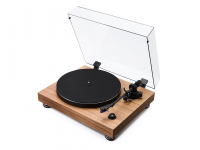
The chances are that if you’ve looked through our huge selection of stereo amplifiers and speakers, you’ll have seen in the specifications whether or not that product is bi-wirable. But what is bi-wiring and what benefits can it bring to your hi-fi system? Here’s our handy guide to get you started…
Essentially bi-wiring is a means of improving the performance of your system, with the addition of another run of speaker cable. It’s an ongoing debate and the benefits are considered minimal, however it is a technique some swear by, especially if you opt for high quality cable and can generally work out cheaper than upgrading your whole system or bi-amping, which we’ll go into further detail on later.

The Tannoy Revolution XT6 is one of the best example speakers that offer bi-wiring.
Speakers
Traditionally, hi-fi speakers house two sockets on the rear of their cabinets. The cables are hooked up to a positive (+) and a negative (-) connection on both amplifier and speaker end. All the information of the music you are listening to is passed along these cables and processed by the speakers.
As you can see in the Tannoy Revolution XT 6 speakers (left), bi-wirable speakers feature four terminals; two (+) and two (-).
In either instance the amplifier send exactly the same signal through single or bi-wired cables. The difference comes in the separation of frequencies at the speaker end of the cable. The internal components (crossover) of a speaker sends the high frequencies and low frequencies to the correct drivers/tweeter. Even though the difference is minimal, many audiophiles claim this bi-wiring method increases the stereo separation and perceived level of detail. The downside, however, is a drop in overall tonal coherence.

The Cambridge Audio Azur 851A allows for dual speaker sets and bi-wiring.
Amplifiers
In order to make full use of bi-wireable speakers, an amplifier should really be capable of outputting the proper signal. Even though it is possible to bi-wire using a single set of speaker terminals, for best results use one amplifier with two sets of speaker outputs, like the Cambridge Audio 851A (left). For true gains however, what we really want to do is to bi-amp…
Bi-amping is the process of using two amplifiers to drive high and low frequencies. This sends twice the power to each speaker, adding greater tonal control, giving more dynamic bass and clear treble. The method of using one amplifier per speaker (one amp for left, one for right) is referred to as monoblocking. This results in greater stereo separation and dynamic sound. Most commonly seen in higher end systems, bi-amping/monoblocking use a pre-amplifier (to control the volume and select inputs) and a pair of power-amplifiers. The most noticeable gains to be heard are greater headroom and enhanced clarity, whilst the handling of transients is improved, also.
About the only thing that people in hi-fi circles agree on when it comes to bi-wiring is that they can’t agree on whether it makes a difference or not! The science seems not to necessarily back it up, but a lot of greatly respected ‘ears in the industry’ recommend it as the way to go. Your mileage may vary, but if it works in your system, it’s a great, cost effective way of getting more from your music. If your system already has some respectable speaker cable in a single-wired configuration, a second run of the same cable to bi-wire the speakers maybe a sensible option. Spending the same amount replacing all your speaker cable, however, it is advised (in terms of value-for-money) single speaker cable gives better results.
Pay us a visit in-store of give our Telesales team a call on 0333 900 0093 for more friendly advice on getting the best possible performance from your system. We can even optimise our home-styled demo rooms for you to try out just about any set-up!
Visit Richer Sounds to shop now.
Author: Chris, Liverpool store





